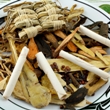Saiko-keishi-to (TJ 10)
Saiko-keishi-to (TJ 10)
Natural Standard Monograph, Copyright © 2013 (www.naturalstandard.com). Commercial distribution prohibited. This monograph is intended for informational purposes only, and should not be interpreted as specific medical advice. You should consult with a qualified healthcare provider before making decisions about therapies and/or health conditions.
Related Terms
Bupleurum, chai-hu-gui-zhi-tang, cinnamon, ginger, ginseng, glycyrrhiza, jujube,Kampo, peony, pinellia, scutellaria, TJ-10.
Background
Saiko-keishi-to is a Japanese herbal formula that is a part of the ever-evolving system of traditional Japanese medicine, called Kampo. A Kampo drug is a standardized and regulated multi-herb formula. Kampo formulas are an essential component of Japanese integrative medicine and are often given to patients alongside Western treatments in even the most mainstream of Japan's hospitals.
Saiko-keishi-to is made up of nine herbs: bupleurum root, pinellia tuber, scutellariaroot, jujubefruit, ginger rhizome, ginseng root, cinnamon bark, peony root and glycyrrhizaroot.
The Chinese name for the formula is chai-hu-gui-zhi-tang. There is no English translation of the formula.
Theory/Evidence
It is commonly used to treat duodenal ulcer, pancreatitis and chronic liver disease.
Studies have evaluated the efficacy of saiko-keishi-to for the treatment of epilepsy, multiple sclerosis and pancreatitis.
Dosing
The below doses are based on scientific research, publications, traditional use, or expert opinion. Many herbs and supplements have not been thoroughly tested, and safety and effectiveness may not be proven. Brands may be made differently, with variable ingredients, even within the same brand. The below doses may not apply to all products. You should read product labels, and discuss doses with a qualified healthcare provider before starting therapy.
Traditionally, the formula is taken by mouth in the form of capsules or tablets. Dosages are usually larger than most Western medicines.
Japanese patients often boil this formula into a tea. However, the smell and taste of it is not appealing to the palate of most Westerners.
Safety
The U.S. Food and Drug Administration does not strictly regulate herbs and supplements. There is no guarantee of strength, purity or safety of products, and effects may vary. You should always read product labels. If you have a medical condition, or are taking other drugs, herbs, or supplements, you should speak with a qualified healthcare provider before starting a new therapy. Consult a healthcare provider immediately if you experience side effects.
Since saiko-keishi-to consists of several herbs, it can potentially interact with other drugs, herbs or supplements. Therefore, a qualified healthcare provider should be consulted before making decisions about therapies and/or health conditions. Avoid if pregnant or breastfeeding.
Author Information
This information has been edited and peer-reviewed by contributors to the Natural Standard Research Collaboration (www.naturalstandard.com).
Bibliography
Natural Standard developed the above evidence-based information based on a thorough systematic review of the available scientific articles. For comprehensive information about alternative and complementary therapies on the professional level, go to www.naturalstandard.com. Selected references are listed below.
Department of Kampo Medicine, Keio University School of Medicine. 10 May 2006. http://web.sc.itc.keio.ac.jp/kampo/vc/catalog/formulas/index3.html
Yoshinori H, Mikio K, Shuka M, et al. Japanese herbal medicine, Saiko-keishi-to, prevents gut ischemia/reperfusion-induced liver injury in rats via nitric oxide. World J Gastroenterol. 2004 Aug 1;10(15):2241-4. View Abstract
Copyright © 2013 Natural Standard (www.naturalstandard.com)
The information in this monograph is intended for informational purposes only, and is meant to help users better understand health concerns. Information is based on review of scientific research data, historical practice patterns, and clinical experience. This information should not be interpreted as specific medical advice. Users should consult with a qualified healthcare provider for specific questions regarding therapies, diagnosis and/or health conditions, prior to making therapeutic decisions.
Updated:
March 22, 2017
